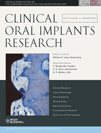Prophylactic agents and bacterial adherence to titanium
Abstract
Aims: An evaluation was made of surface alterations of commercially pure titanium and Ti6Al4V alloy caused by fluoride at the concentration present in dentifrices and oral mouth washes (1500 ppm), and by prophylactic use of airborne particle abrasion with bicarbonate of soda.
Materials and methods: For each material, 60 pre-fabricated disk-shaped test specimens with industrial metallographic finish, measuring 5 mm in diameter and 3 mm thick, were divided into four groups, according to the storage solutions: artificial saliva pH 7.0 (G1), fluoridated artificial saliva pH 5.5 (G2), airborne particle abrasion with bicarbonate of sodium (G3), airborne particle abrasion with bicarbonate of sodium followed by storage in fluoridated artificial saliva (G4). The surface roughness (Ra) was measured with a profilometer, before and after the storage periods. Afterwards, the test specimens were submitted to Streptococcus mutans adherence.
Results: A statistically significant reduction in surface roughness was observed in commercially pure titanium in G1, G4 and in Ti6Al4V alloy, G1, G2, G4, and no statistically significant reduction in G3.
Discussion: With a mean initial roughness surface of Ra=0.2 μm, fluoride promoted homogenization. Microscopy images confirmed these results. In the groups without significant homogenization, S. mutans adherence was greater, whereas it was lower in the groups in which the test specimens were stored previously in fluoridated saliva.
Conclusion: The greater homogenization that occurred, as well as the antimicrobial effect of fluoride, proved that bacterial adherence and effects of fluoride were both dependent on the roughness of the surface topography.
To cite this article: Barros RN, Gouvêa CVD. Prophylactic agents and bacterial adherence to titanium.Clin. Oral Impl. Res. 22, 2011; 1221–1226.doi: 10.1111/j.1600-0501.2010.02099.x




